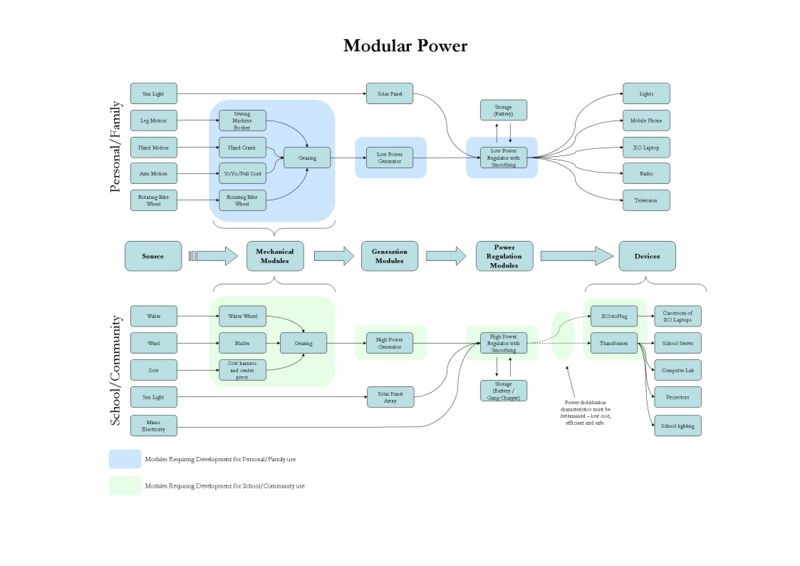Peripherals/Modular Power
Jump to navigation
Jump to search
A power generation solution that allows users to create customized solutions to best suit the environment in which they live. The different components include;
- Mechanical Modules - Various mechanical systems with gearing which connect to the generator.
- Generation Modules - Different sized generators to fit the needs of the user.
- Power Regulation Modules - A range of regulators capable of controlling different amounts of power.
Location and Intended Users
Everywhere that requires stable power.
Motivation
- Power generation solutions are the most requested peripheral.
- No one solution is going to solve the power problem in developing countries.
Advantages
- This solution takes advantage of local skills and the local environment.
- Surges or spikes in power will not damage attached equipment.
Disadvantages
- Different Gear ratios will be required to run at maximum efficiency - this could add cost.
- Different situations will have different variability in the power generated.
- One possible workaround for power variability is to create responsive power consumers - e.g. a multi-charger that only charges as many of its slots as there is power for. But that is another design challenge.
Suggestions
Text
Example of Use
In any of the situations below a storage solution, such as car batteries or the gang charger, could be attached to the power regulator creating an uninterruptible power supply (UPS).
- Two different schools may both require power, but exist in two very different environments. One has regular strong winds, and the other has a fast moving river near by. To get the most reliable power solution possible both schools require the power regulator and generator, but should select different mechanical modules - the blades for wind and the water wheel for the river. Because both schools are purchasing 2 identical modules the cost will go down due to economies of scale, but because they have different mechanical modules they are still getting a custom power solution.
- For some locations the mechanical module and generator could be assembled from locally available materials representing the lowest cost option. However they may still require the intelligence of the power regulator to guarantee the safety of equipment attached to this power solution.
- In some locations electronic equipment may be rare but the understanding and inventiveness of local people to create a mechanical system to drive the generator should be leveraged to enable the best power generation solution. In this situation the power regulator and generator could be purchased and have the custom build mechanical system attached in field.
- Some schools are already connected to the countries electricity supply so don’t require any generation mechanism. However, in many countries large power spikes or power cuts are common. The power regulator would protect the schools electricity supply preventing damage to electronic equipment and could also act as a UPS if batteries were hooked up to the storage output of the power regulator.
Contributors
- Concept: Joshua Seal, 15th October 2007
